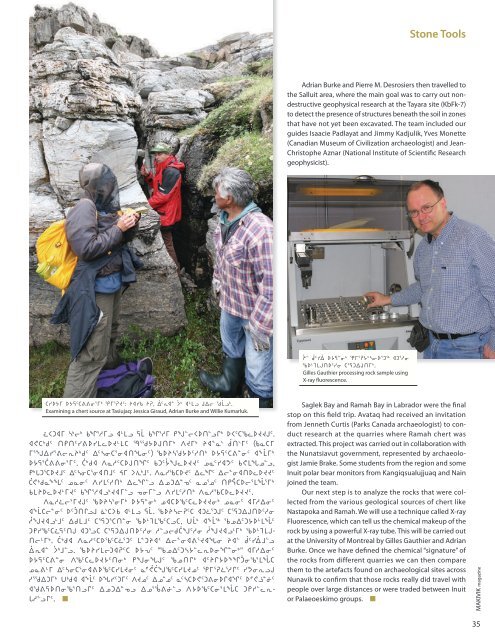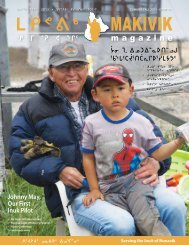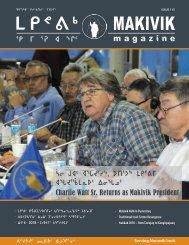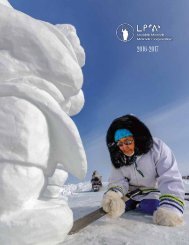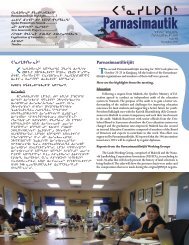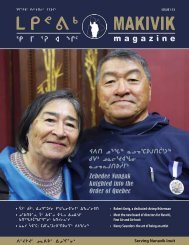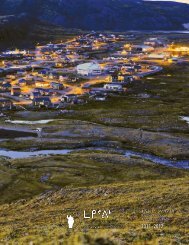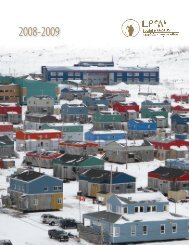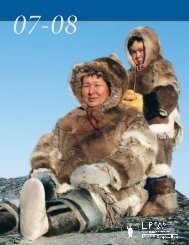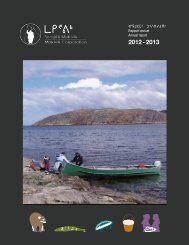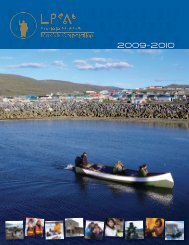Create successful ePaper yourself
Turn your PDF publications into a flip-book with our unique Google optimized e-Paper software.
xxxxxxxxxx<br />
Stone Tools<br />
Adrian Burke and Pierre M. Desrosiers then travelled to<br />
the Salluit area, where the main goal was to carry out nondestructive<br />
geophysical research at the Tayara site (KbFk-7)<br />
to detect the presence of structures beneath the soil in zones<br />
that have not yet been excavated. The team included our<br />
guides Isaacie Padlayat and Jimmy Kadjulik, Yves Monette<br />
(Canadian Museum of Civilization archaeologist) and Jean-<br />
Christophe Aznar (National Institute of Scientific Research<br />
geophysicist).<br />
º9 ƒ5y s/C8i4 eu3D/5nos3g6 xg3hi<br />
cs7àmAts5hi b3CgwAtu4.<br />
Gilles Gauthier processing rock sample using<br />
X-ray fluorescence.<br />
bys/u s/C5b[[i3u4 eu3DJ5: pxyv pD, 5Ex8 Í4 x7ml Awo dµl4.<br />
Examining a chert source at Tasiujaq: Jessica Giraud, Adrian Burke and Willie Kumarluk.<br />
˜Xgxu n4o4 vq3hul x7ml Cµ vq3hu ra9oXst9lQ4 sX5bcMsJJA5.<br />
x?b4f5 trt5y[symMsJ7mb ò3dIsAtu4 WJu4 px8N+ ƒt+u5 GvNbu<br />
u3awy3[oEp4f5 w5nib3ixtzi5H cspndIs5ht4 sIC5b[8i5 x1µu4<br />
sIC3Ì[[i3u5. Ì4fx WNh5bsAtq5 vg5÷aMsJJ5 kN5yxK5 v?mzk9l,<br />
r4Zg3bsJj5 w5nib3ixtj5 èu S‰4j5. WNhcbsJ5 wMq5 wo8ixtsMsJJ5<br />
Ì?4fN1z5 kNi5 Wym5ht4 wMq9l wkgw8â5 Nk3k5 trÇbso3m¯3u4<br />
vmpsMsJ7uJ5 vq3hxl4Jxu9l âiu9l Wym5ht4 WNhcbsMsJJ5.<br />
WNh˜o3uJA5 cspn3iu4 sIC8i4 kxbsc5bMsJJi4 kNi5 xuhwi5<br />
x1µbo8i5 s5©tQlA ˆ+bSv x7ml Cµ. cspnoD5b xg˜3gA5 b3CgwAts5hi<br />
§aJxl7j5 wfmj5 b3Cg3bt8i cs7àmc5blb, Öµ4 x1µ6 ckw5gIs7m¯5<br />
gryc5b˜C5tA xg3lb b3CgwAts5hi h9lofÌa5hi §aJxl7u4 cs7àmAto7u4.<br />
Ì4fx WNh5bsc5b˜3g5 m8gpx2 wo8ix[3Jxzi px9 ƒ5yj9l<br />
Ex8 Í4j9l. cspymogxD5b sIê5 >ckw5gnI9MEsiq8i4> xuhwi5<br />
sIC5b[8i Wc5bMsJI5ti4 raizA5 cktQ4 x5pQIs1q©ic3m¯b<br />
kN[7u w5nib3ix[sc5bymJi5 N{¿Ìac5bymJk5 eu3D˜3hQ5 yKiElA<br />
h3dwgu4 Ö4fx x1µ5 szy5gu5 WJk5 wk8k5 N5nbs?5g[isQxq5 s{?¬8î5<br />
xd[Cstic3tlQ5 wkgw8âl wk3ç[î9l WIsc5bi3m¯b gry9ME-<br />
Zh9lQ5.<br />
Saglek Bay and Ramah Bay in Labrador were the final<br />
stop on this field trip. Avataq had received an invitation<br />
from Jenneth Curtis (Parks Canada archaeologist) to conduct<br />
research at the quarries where Ramah chert was<br />
extracted. This project was carried out in collaboration with<br />
the Nunatsiavut government, represented by archaeologist<br />
Jamie Brake. Some students from the region and some<br />
Inuit polar bear monitors from Kangiqsualujjuaq and Nain<br />
joined the team.<br />
Our next step is to analyze the rocks that were collected<br />
from the various geological sources of chert like<br />
Nastapoka and Ramah. We will use a technique called X-ray<br />
Fluorescence, which can tell us the chemical makeup of the<br />
rock by using a powerful X-ray tube. This will be carried out<br />
at the University of Montreal by Gilles Gauthier and Adrian<br />
Burke. Once we have defined the chemical “signature” of<br />
the rocks from different quarries we can then compare<br />
them to the artefacts found on archaeological sites across<br />
Nunavik to confirm that those rocks really did travel with<br />
people over large distances or were traded between Inuit<br />
or Palaeoeskimo groups.<br />
MAKIVIK mag a zine<br />
35


